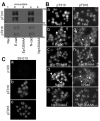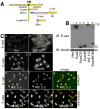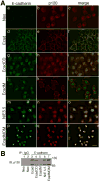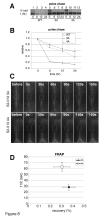The regulatory or phosphorylation domain of p120 catenin controls E-cadherin dynamics at the plasma membrane
- PMID: 17719574
- PMCID: PMC2211447
- DOI: 10.1016/j.yexcr.2007.07.024
The regulatory or phosphorylation domain of p120 catenin controls E-cadherin dynamics at the plasma membrane
Abstract
In contrast to growth factor-stimulated tyrosine phosphorylation of p120, its relatively constitutive serine/threonine phosphorylation is not well understood. Here we examined the role of serine/threonine phosphorylation of p120 in cadherin function. Expression of cadherins in cadherin-null cells converted them to an epithelial phenotype, induced p120 phosphorylation and localized it to sites of cell contact. Detergent solubility and immunofluorescence confirmed that phosphorylated p120 was at the plasma membrane. E-cadherin constructs incapable of traveling to the plasma membrane did not induce serine/threonine phosphorylation of p120, nor did cadherins constructs incapable of binding p120. However, an E-cadherin cytoplasmic domain construct artificially targeted to the plasma membrane did induce serine/threonine phosphorylation of p120, suggesting phosphorylation occurs independently of signals from cadherin dimerization and trafficking through the ER/Golgi. Solubility assays following calcium switch showed that p120 isoform 3A was more effective at stabilizing E-cadherin at the plasma membrane relative to isoform 4A. Since the major phosphorylation domain of p120 is included in isoform 3A but not 4A, we tested p120 mutated in the known phosphorylation sites in this domain and found that it was even less effective at stabilizing E-cadherin. These data suggest that serine/threonine phosphorylation of p120 influences the dynamics of E-cadherin in junctions.
Figures








Similar articles
-
Tyrosine phosphorylation of p120(ctn) in v-Src transfected L cells depends on its association with E-cadherin and reduces adhesion activity.J Cell Sci. 2001 Feb;114(Pt 3):503-12. doi: 10.1242/jcs.114.3.503. J Cell Sci. 2001. PMID: 11171320
-
p120 serine and threonine phosphorylation is controlled by multiple ligand-receptor pathways but not cadherin ligation.Exp Cell Res. 2006 Oct 15;312(17):3336-48. doi: 10.1016/j.yexcr.2006.07.007. Epub 2006 Jul 25. Exp Cell Res. 2006. PMID: 16935280
-
Selective uncoupling of p120(ctn) from E-cadherin disrupts strong adhesion.J Cell Biol. 2000 Jan 10;148(1):189-202. doi: 10.1083/jcb.148.1.189. J Cell Biol. 2000. PMID: 10629228 Free PMC article.
-
Role of p120-catenin in cadherin trafficking.Biochim Biophys Acta. 2007 Jan;1773(1):8-16. doi: 10.1016/j.bbamcr.2006.07.005. Epub 2006 Jul 21. Biochim Biophys Acta. 2007. PMID: 16949165 Review.
-
Protecting your tail: regulation of cadherin degradation by p120-catenin.Curr Opin Cell Biol. 2004 Oct;16(5):522-7. doi: 10.1016/j.ceb.2004.07.001. Curr Opin Cell Biol. 2004. PMID: 15363802 Review.
Cited by
-
Interaction of p190RhoGAP with C-terminal domain of p120-catenin modulates endothelial cytoskeleton and permeability.J Biol Chem. 2013 Jun 21;288(25):18290-9. doi: 10.1074/jbc.M112.432757. Epub 2013 May 7. J Biol Chem. 2013. PMID: 23653363 Free PMC article.
-
p120 catenin: an essential regulator of cadherin stability, adhesion-induced signaling, and cancer progression.Prog Mol Biol Transl Sci. 2013;116:409-32. doi: 10.1016/B978-0-12-394311-8.00018-2. Prog Mol Biol Transl Sci. 2013. PMID: 23481205 Free PMC article. Review.
-
Proteomic Analysis Reveals a Role for RSK in p120-catenin Phosphorylation and Melanoma Cell-Cell Adhesion.Mol Cell Proteomics. 2020 Jan;19(1):50-64. doi: 10.1074/mcp.RA119.001811. Epub 2019 Nov 2. Mol Cell Proteomics. 2020. PMID: 31678930 Free PMC article.
-
Myosin Vb uncoupling from RAB8A and RAB11A elicits microvillus inclusion disease.J Clin Invest. 2014 Jul;124(7):2947-62. doi: 10.1172/JCI71651. Epub 2014 Jun 2. J Clin Invest. 2014. PMID: 24892806 Free PMC article.
-
Novel truncating mutations in CTNND1 cause a dominant craniofacial and cardiac syndrome.Hum Mol Genet. 2020 Jul 21;29(11):1900-1921. doi: 10.1093/hmg/ddaa050. Hum Mol Genet. 2020. PMID: 32196547 Free PMC article.
References
-
- Takeichi M. Morphogenetic roles of classic cadherins. Curr Opin Cell Biol. 1995;7:619–627. - PubMed
-
- Wheelock MJ, Johnson KR. Cadherins as modulators of cellular phenotype. Annu Rev Cell Dev Biol. 2003;19:207–235. - PubMed
-
- Thoreson MA, Reynolds AB. Altered expression of the catenin p120 in human cancer: implications for tumor progression. Differentiation. 2002;70:583–589. - PubMed
Publication types
MeSH terms
Substances
Grants and funding
LinkOut - more resources
Full Text Sources
Other Literature Sources

